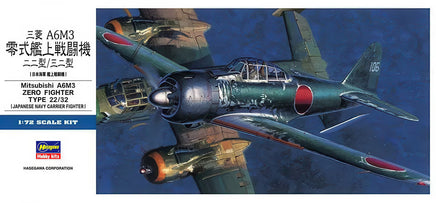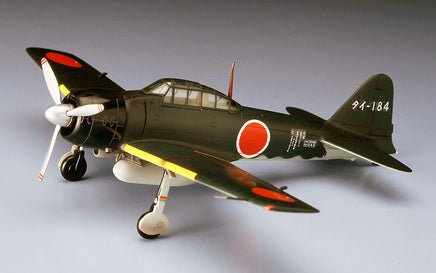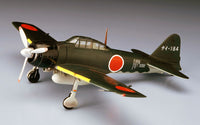The Zero fighter, which marked the early stages of the war with victory, was an excellent aircraft that achieved the best possible flight performance with an engine producing less than 1,000 horsepower. Because of its outstanding capabilities, both the manufacturer and the military sought further improvements. As a result, development of the A6M3 model—including an engine replacement—began in early 1941, a year before the outbreak of the Pacific War.
The main focus of development differed slightly between parties: the manufacturer aimed to improve high-altitude performance through engine replacement, while the military emphasized eliminating the wing-folding mechanism to enhance roll rate and speed performance, as well as improving production efficiency and ease of maintenance.
The aircraft was equipped with the upgraded Sakae 21 engine, which featured a single-stage, two-speed supercharger. To absorb the increased horsepower, a Hamilton constant-speed propeller with a diameter 15 cm larger was installed. Although engine performance improved, the added weight necessitated significant changes to the mounting structure and fuselage, resulting in a shorter fuselage compared to the A6M2 Model 21. The cowling was redesigned for better aerodynamics, and the carburetor intake was moved from the bottom to the top. The wing tips were reshaped into square ends, shortening the wingspan by a total of 1 meter. The fixed 20 mm wing-mounted cannons were replaced with the Type 99 Model 2 cannons, which had increased ammunition capacity.
This modified A6M3 made its first flight on July 14, 1941. After extensive testing, it was adopted by the Navy as the Type Zero Carrier-Based Fighter Model 32 and deployed to the Solomon Islands and the Southwest Pacific, where it saw active service.
While these modifications improved speed and roll rate, they significantly reduced maneuverability in level flight and the long-range capability that had been a hallmark of the Zero. Initially, this wasn’t a major issue, but as long-range missions from Rabaul to Guadalcanal began, the lack of range became a serious concern.
To address this, a new variant was developed with the wingspan restored to 12 meters and additional fuel tanks installed in the outer wings. This version was adopted on January 29, 1943, as the Type Zero Carrier-Based Fighter Model 22.
Compared to the Model 32, the Model 22 had extended range. While the newer Model 32 was reassigned to training units, the Model 22 became the main fighter in aerial battles over the Solomon Islands. Additionally, both models had sub-variants—Model 22 Ko and Model 32 Ko—which featured long-barreled Type 99 Model 2 cannons in the wings.
Specifications:
Mitsubishi A6M Zero Carrier-Based Fighter Model 22
- Crew: 1
- Wingspan: 12.00 m
- Length: 9.060 m
- Height: 3.570 m
- Maximum Speed: 540.8 km/h (at 6,000 m altitude)
- Engine: Sakae 21 (Takeoff Power: 1,130 hp)
- Armament: Two 7.7 mm machine guns, two 20 mm cannons
Mitsubishi A6M Zero Carrier-Based Fighter Model 32
- Crew: 1
- Wingspan: 11.00 m
- Length: 9.060 m
- Height: 3.570 m
- Maximum Speed: 544.5 km/h (at 6,000 m altitude)
- Engine: Sakae 21 (Takeoff Power: 1,130 hp)
- Armament: Two 7.7 mm machine guns, two 20 mm cannons




